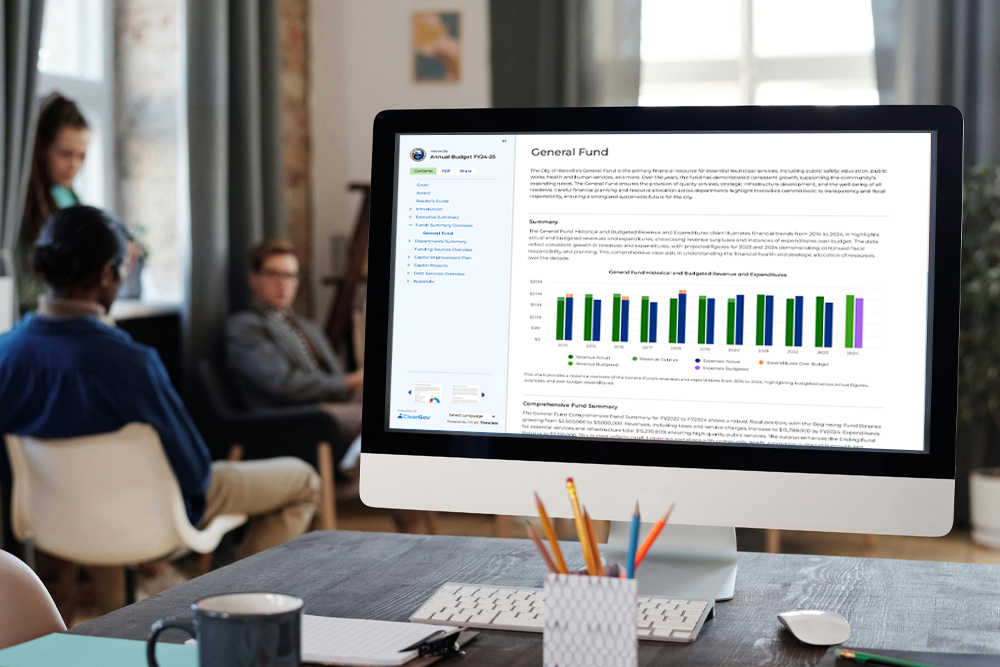Top 7 Budgeting Challenges for Local Government Finance Directors Updated on August 23, 2024 A finance director’s role in keeping their government running like a well-oiled machine cannot be understated, and these days the position may be more demanding than ever! This is especially true for smaller towns where the finance director may wear many hats and have limited staff to delegate to. Let’s look at the top 7 challenges of local government finance directors during the budgeting process, and how ClearGov can help. 1. Changing Revenue LandscapesChallenge: The GFOA’s Rethinking Revenue initiative explores the challenge of how today’s revenue systems are misaligned with the modern economy. While property taxes have traditionally been a primary revenue source, much of today’s economic value lies in intangible assets like digital goods and financial instruments, which aren’t taxed in the same way. Similarly, sales taxes, which have only recently been applied to online sales, still largely miss the growing online service sector. Finally, overuse of and reliance on fines and fees can be unfair to citizens. Solution: Finance directors need to rethink their approach to revenue. Using resources like the GFOA initiative, finance directors can:
ClearGov’s software supports these efforts by providing:
2. Limited Time & ResourcesChallenge: With shrinking resources, finance directors are often stretched thin and forced to juggle multiple responsibilities. In many cases, miscellaneous tasks that don’t fit into other departments are left to the finance director to handle. In smaller towns, the finance ‘department’ may in fact be a one-person show with no one to delegate to. This makes the time a finance director does have, incredibly valuable. Manually consolidating spreadsheets, entering data in multiple places, and reconciling the budget to check for errors and broken formulas is tedious and a poor use of time. Solution: While these budget management tasks are critical, manual methods are inefficient and error-prone. A better use of a finance director’s time is to utilize a cloud-based budgeting solution to streamline these time-consuming tasks. ClearGov’s software supports these efforts by providing:
3. Changing TechnologyChallenge: Technology has changed so rapidly in recent years that it can be difficult to keep up with — especially for finance directors who have spent their entire career in government and can recall building their budget pre-internet. While many finance directors have successfully moved their budgets from paper to spreadsheets, there is still room to grow in the next evolution of solutions through modern cloud-based software. Those who have recognized the shortcomings of legacy systems have benefited greatly from the efficiencies of modern technology. Those who have not have continued to perform time-consuming, error-prone, tasks like manual data entry, consolidation, and reconciliation. While it may technically get the job done, there are glaring inefficiencies in the process that are compounded by the challenge of shrinking resources and staff. Solution: The shift from manual processes to modern cloud-based solutions requires new skills and a willingness to adapt. When tasked with providing the same services with fewer resources, it’s more important than ever for today’s finance directors to understand how to use technology to drive long-term success for their communities. ClearGov’s software supports these efforts by providing:
4. Fiduciary Responsibility To CommunityChallenge: Citizens have become more involved in the budgeting process, and they expect clear communication that holds their government accountable for its fiduciary responsibilities. This requires an extremely careful recordkeeping and reporting process to keep elected officials accountable and to keep citizens informed. Despite this, new research from Polco and the National Research Center, has found that nearly half of Americans have a “less than favorable view” of the trustworthiness of their local government. In another study, over 200 government employees involved in budgeting, including city and county managers, budget directors, and CIOs, were surveyed about their current processes and obstacles to change. Many respondents felt that their budgeting processes didn’t effectively engage residents, align with their priorities, or make the process easy to understand. Less than half thought residents were satisfied with the current budgeting approach.
Solution: Citizens’ demand for greater transparency and accountability puts more pressure on finance directors to keep meticulous records and effectively communicate the budget. A transparency portal can help restore and build public trust by making the budgeting process more transparent and engaging. ClearGov’s software supports these efforts by providing:
5. Fostering Civic EngagementChallenge: In line with the focus on a government’s fiduciary responsibility is how to foster civic engagement within a community. Without resident input, it’s impossible to know what programs, services, and capital projects matter most. It’s critical to have residents involved in the planning and budgeting process to prioritize projects. To that end, governments are tasked with increasing effective, efficient communication with citizens, including budget strategy, the budgeting process, and the final budget itself. But what’s the best way to communicate with them? Email, social media, town hall meetings? This is a serious challenge every finance director faces as they attempt to involve their communities in the decisions that matter most. Solution: Every town and city will be different depending on the demographics, accessibility to technology, and resident preference. It takes polling through multiple channels to get a pulse on a community’s preferences. With a transparency portal, governments can easily share the link on their website, on social media, in neighborhood groups, and anywhere else residents are. ClearGov’s software supports these efforts by providing:
6. Effective Internal CommunicationChallenge: Local governments have shifted toward more hybrid and decentralized work models. Consequently, finance directors need to find new ways to collaborate more closely with other departments, which requires strong leadership, management, and communication skills. When it comes to the budget, many governments are finding that pooling resources and combining contracts (i.e. using the same vendor for landscaping for parks and schools) can save them significant money. But unless departments are effectively communicating with one another, these efficiencies could be missed. Technology is critical for effective internal communication, but adopting new technology can be a challenge. This can lead to departments becoming ‘siloed’ and essentially operating with blinders on with regard to how they fit into the overall government organization. Solution: Whether the communication challenges stem from the shift to a hybrid work model or from departments becoming siloed over time, a cloud-based government budgeting solution can enable real-time collaboration between the finance director and departments. ClearGov’s software supports these efforts by providing:
7. Long-Range Planning For Capital & Personnel BudgetingChallenge: Capital and personnel planning are complicated by rising material costs, healthcare costs, and the added complexity of union negotiations and pensions. Therefore, it’s critical to be able to create multiple scenarios that account for these variables. Finance directors using a spreadsheet for these budgets are likely leveraging multiple tabs, countless formulas, and links that connect the different scenarios. Checking and double-checking every time they make a change is exhausting. At the end of the day, spreadsheets simply don’t have the visibility needed to efficiently analyze and compare scenarios against each other. Solution: Instead of using spreadsheets to manually create multiple scenarios, a better solution is for finance directors to use highly visual, organized, and easy-to-use modern software for effective long-range planning. ClearGov’s software supports these efforts by providing:
ClearGov Helps Lighten The LoadClearGov’s government budgeting software helps finance directors lighten the load to better tackle these seven challenges. With ClearGov, Finance directors are empowered to budget more effectively by saving time, money, and human resources— all invaluable assets in today’s current environment. Best of all, ClearGov is EASY to use. Even finance directors and department heads who have been resistant to changing technology, actually quickly adopt our software, and they’re amazed at how easily the software automates the process to Collect, Create, and Communicate their budget. Watch a demo now, or contact us to learn how ClearGov can help lighten the load! |












